
Drought-resistant hedge shrubs
A selection of shrubs to make your hedges shine
Contents
Hedges are essential in the garden: you plant them to isolate your little piece of nature from views and wind, to mark and separate different areas of the garden, to shelter the terrace or pool area… However, on the other hand, you will increasingly have to deal with water shortages across the country, and let’s face it, it’s a shame to use drinking water to irrigate them! Your planting projects for this season lead you to install a hedge at home? Follow our tips to choose shrubs for hedges that are drought-resistant.
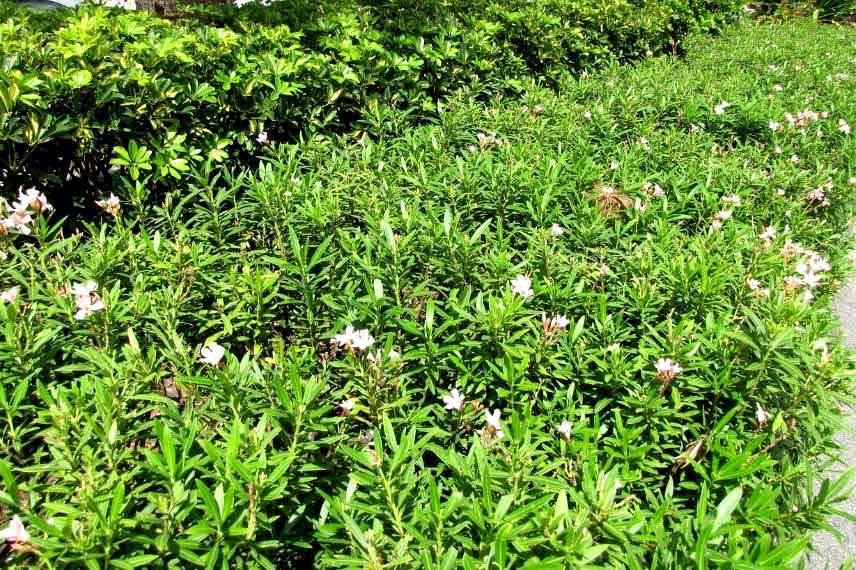
Hedge for dry soil with Oleander and Pittosporum tobira
Evergreen shrubs
Evergreen shrubs (which retain their foliage all year round) will form the backbone of your hedge. Depending on the type, you can choose from different options: a completely evergreen hedge for a privacy and/or windbreak effect, 2/3 evergreens for a mixed hedge that is rather opaque, or 1/3 evergreens if you want it to maintain some transparency. Whatever way you integrate them into your planting project, you can choose from these reliable options:
- Pittosporum heterophyllum, also known as Chinese Orange, is a beautiful dense evergreen shrub with elegant, glossy green foliage. Its small cream flowers, grouped in bouquets that bloom in spring, are delightfully fragrant. Very drought-resistant, it is also hardy down to -10°C. The Pittosporum tobira, widely used in southern hedges, will have almost the same characteristics, with rounder and broader foliage.
- The Narrow-leaved mock privet Phillyrea angustifolia: with a somewhat slow growth rate, the Mock Privet gradually establishes itself to form a very beautiful, dense, and robust shrub.
- Pistacia lentiscus or Mastic tree is a well-known natural host around the Mediterranean. It thrives in poor, stony soils and copes admirably with drought.
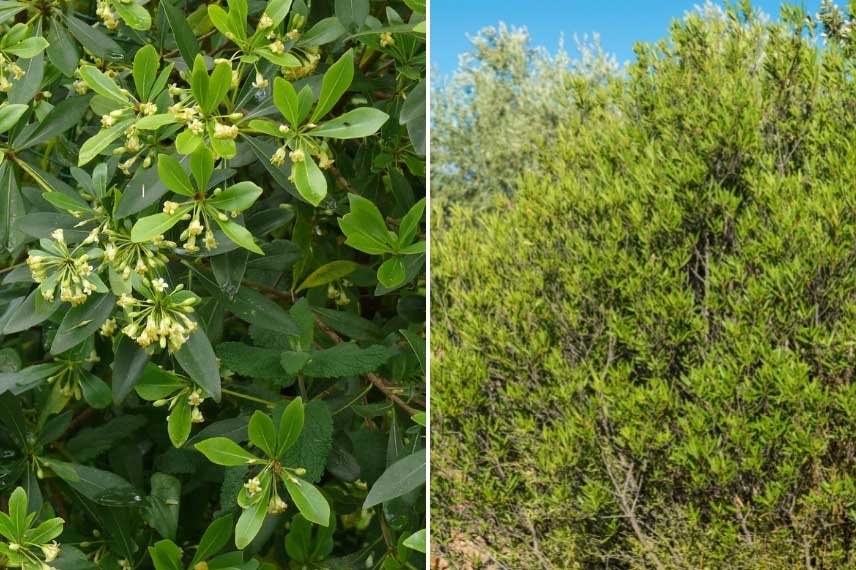
Pittosporum heterophyllum and Pistacia lentiscus
Read also
Hedge for birds: which shrubs to choose?Deciduous shrubs
Deciduous shrubs (which lose their foliage in winter) will help maintain transparency and lightness in your hedge. Among the most resilient in dry soil, you can choose from:
- The Chaste tree or Vitex agnus-castus ‘Latifolia’. This large, vigorous Mediterranean shrub is easy to grow and boasts beautiful lavender-blue flowering in summer.
- Hawthorn or White thorn – Crataegus monogyna, which is both easy to cultivate and very floriferous in spring, becoming completely veiled in tiny white flowers for long weeks.
- Prunus spinosa or Blackthorn, which will give your hedge a lovely rustic appearance. Its white flowering will brighten up spring, followed by small berries that birds love.

Vitex agnus-castus ‘Latifolia’, Crataegus monogyna and Prunus spinosa
Discover other Hedge shrubs
View all →Available in 0 sizes
Available in 1 sizes
Available in 1 sizes
Available in 1 sizes
Available in 1 sizes
Available in 1 sizes
Available in 1 sizes
Available in 1 sizes
Available in 2 sizes
Available in 1 sizes
Flowering shrubs
Highlights of your hedge, flowering shrubs, if chosen wisely, will provide beautiful colours in the garden throughout the seasons:
- Flowering Pomegranate – Punica granatum ‘Maxima Rubra’, very accommodating to soil type, will be perfectly suited to drought. Its magnificent double orange flowers will bring vibrancy to your hedge all summer long.
- Oleander: a classic in southern gardens, which you can harmonise according to the shades that appeal to you most: from pure white to red, including light pink or yellow tones, with either double or single flowers. There are numerous varieties, all sharing a great adaptation to water scarcity.
- Bottlebrush or Callistemon: here too, beautiful bright and cheerful shades, borne on branches with evergreen and leathery leaves. Callistemons have a bottlebrush flowering, either spring or more summer-flowering depending on the variety.
- Many varieties of Lagerstroemia, also known as Crape Myrtle, are suitable for planting in hedges. Some are red, others fuchsia pink or white, but again they will be resilient subjects resistant to water stress.
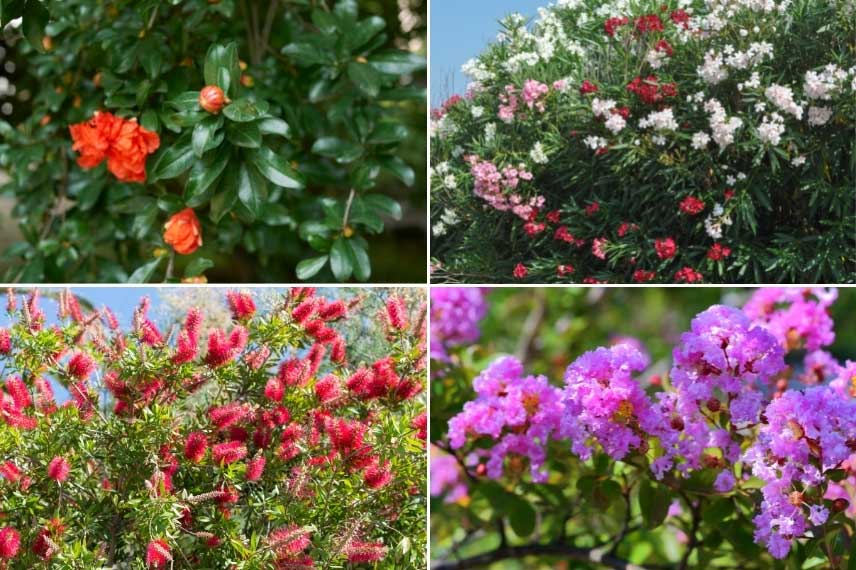
Punica granatum ‘Maxima Rubra’, Oleanders, Callistemon and Lagerstroemia
Decorative foliage shrubs
Decorative foliage is an interesting alternative to flowers. It enlivens hedges, brightens them up, or energises them with vibrant colours:
- Rhamnus alaternus ‘Argenteovariegata’: a somewhat lesser-known evergreen shrub that is very interesting, equally at home in sun or shade. With a fairly rapid growth rate, it will form beautiful masses of dense, grey-green foliage marginate with white.
- Smoke trees Cotinus coggygria ‘Golden Lady’ and Cotinus coggygria ‘Royal Purple’: the first of these Smoke Trees, named for their very original fluffy flowering, boasts lovely foliage that changes colour with the seasons, from golden green to fiery orange. The second has darker foliage, a beautiful purple that gives it a strong identity, ideal for a hedge full of contrasts.
- Photinia ‘Red Robin’: a classic hedge shrub. Evergreen and well-suited to pruning, the Photinia displays lovely copper-red colours on its young shoots, contrasting with the rest of the deep green foliage.
- Aucuba japonica ‘Golden King’ or Spotted Laurel will be reserved for hedges exposed to shade or partial shade. Nevertheless, it easily adapts to all types of soil and also thrives in dry conditions. Its evergreen golden-yellow foliage is speckled with dark green.

Cotinus coggygria ‘Golden Lady’, Cotinus coggygria ‘Royal Purple’ and Photinia ‘Red Robin’
Decorative fruiting shrubs
In addition to decorative flowers and foliage, some shrubs suitable for drought-prone hedges feature colourful fruits that add undeniable ornamental value:
- Well-known to gardeners, Pyracanthas, also known as Firethorn bushes, do have thorns, but they also bear a multitude of small colourful berries from late summer to the heart of winter: depending on your preferences, you can choose from orange, red, or yellow berries, whether you opt for Pyracantha coccinea ‘Saphyr Orange’, Pyracantha coccinea ‘Saphyr Rouge’, or Pyracantha coccinea ‘Saphyr Jaune’. Very easy to train into hedges, including defensive ones due to their thorny nature, Pyracanthas tolerate drought conditions well and provide a splash of colour out of season when the rest of the garden is resting.
- The Strawberry Tree, also known as “Tree of Strawberries,” is named for its edible red fruits that resemble strawberries. Among these, Arbutus unedo ‘Rubra’ is notable for its size and more compact habit compared to the species, making it particularly well-suited for a hedge in dry conditions. Naturally growing in scrubland landscapes, the Strawberry Tree is well adapted to challenging conditions.
- Cotoneaster lacteus: fast-growing and very hardy, the cotoneaster is often used as a hedge shrub. In addition to its deep green evergreen foliage, it produces lovely white flowers in spring followed by bright red berries that birds find very appealing.
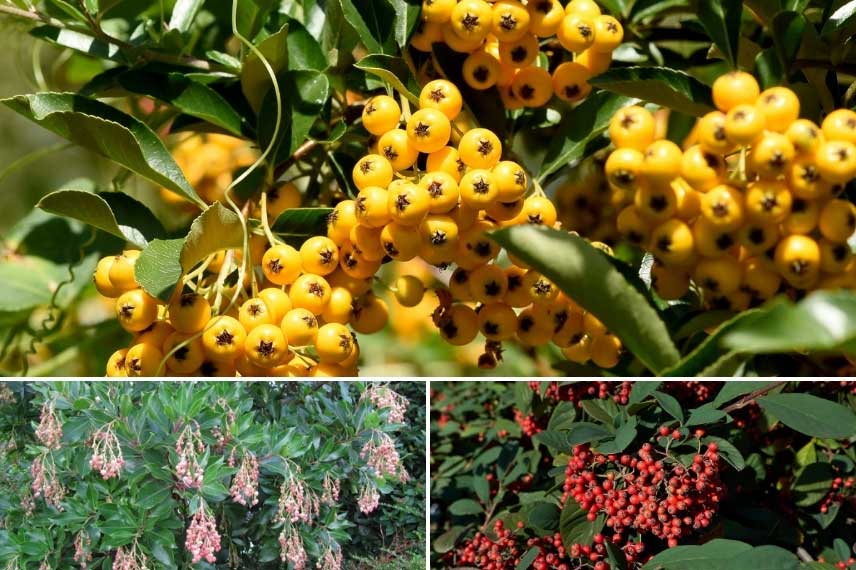
Pyracantha coccinea ‘Saphyr Jaune’, Arbutus unedo ‘Rubra’ in bloom, and Cotoneaster lacteus
Fast-growing bushes
Generally, planting a hedge is linked to the desire for quick growth: the most impatient gardeners are those wishing to create a privacy screen to fully and peacefully enjoy their garden. Some drought-resistant hedge shrubs also tick this box: a rapid growth rate that makes them almost indispensable subjects:
- Among the fast growers, Butterfly bush stand out. Choose without hesitation from the varieties of Buddleia davidii that you like best: with purple, violet, pink, or white flowers, they share a long flowering period that is very attractive to butterflies and a great resistance to drought.
- California privets Ligustrum ovalifolium and Ligustrum ovalifolium ‘Argenteum’ with cream variegated foliage are also very good fast-growing hedge shrubs.
- Barberry Berberis darwinii, an alternative to Pyracantha due to its thorny nature, also has a rapid growth rate, making it interesting for those who want to see their hedge establish quickly. Its magnificent orange flowering brightens up spring, it is easy to prune, and adapts perfectly to dry and poor soils.
- Grevillea rosmarinifolia is an evergreen shrub with foliage similar to that of rosemary, hence its name. It flowers from February until early summer, producing stunning bright pink flowers. Native to Australia, this shrub is particularly resistant to difficult growing conditions, diseases, and drought.
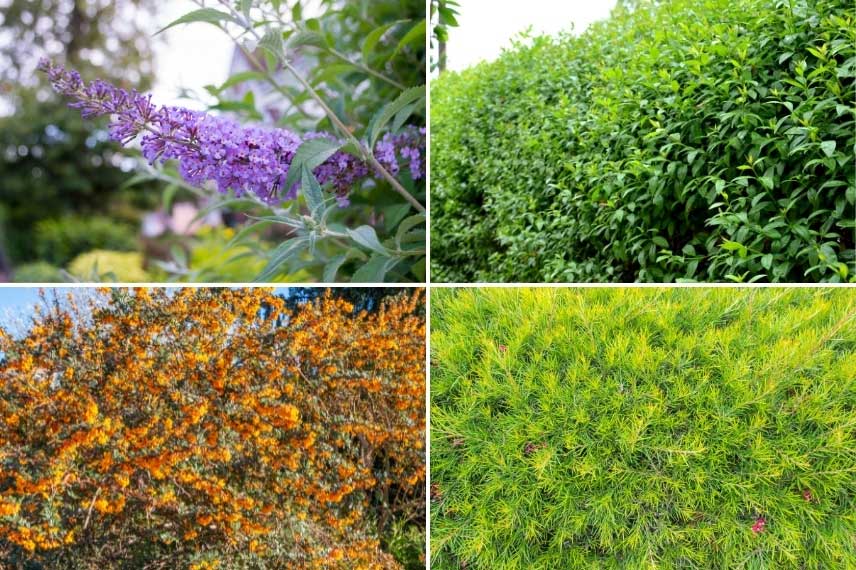
Buddleia davidii, Ligustrum ovalifolium, Berberis darwinii and Grevillea rosmarinifolia
Shrubs by soil Type
Depending on the soil conditions you can provide, you can choose from the following shrubs, all suited to dry conditions.
In poor, well-draining soil:
- Grevillea juniperina
- Common Gorse Ulex europaeus
- Cypress Cupressus sempervirens ‘Totem’ and Cupressus sempervirens ‘Pyramidalis’
In clay soil:
- Butterfly Bushes Buddleia alternifolia and Buddleia weyeriana ‘Sungold’
- Colutea arborescens, also known as Bladder Senna
Shrubs for the seaside
Among the shrub varieties suitable for dry hedges, we can mention for a first-line exposure facing maritime spray:
- Grevillea juniperina ‘Canberra Gem’
- Sea Beet Atriplex halimus
- Euonymus japonicus or Japanese Spindle
- Common Myrtle Myrtus communis ‘Tarentina’
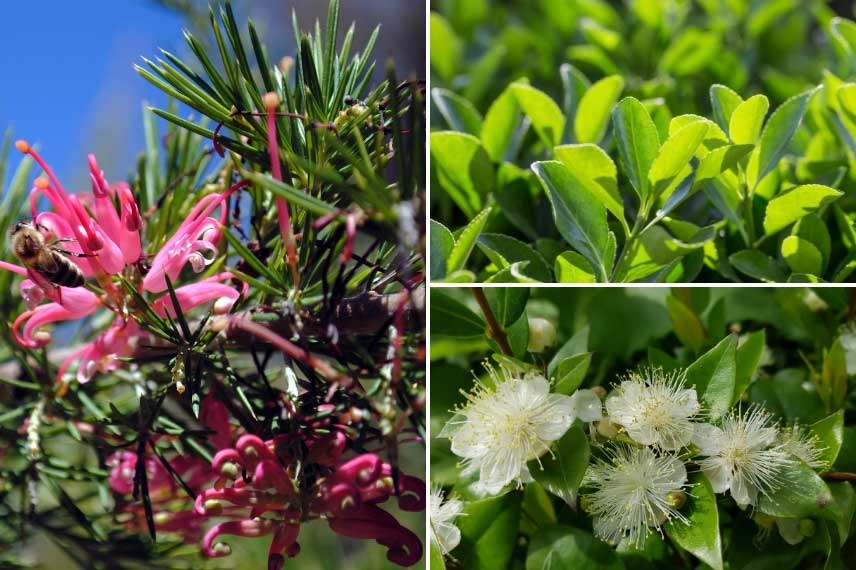
Grevillea juniperina ‘Canberra Gem’, Euonymus japonicus, and Myrtus communis ‘Tarentina’
Shrubs that withstand pruning best
An alternative to the free-standing hedge, often due to a lack of space to allow shrubs to express their natural habit, the trimmed hedge requires the planting of subjects that can withstand the regular passage of the hedge trimmer. Among these, you can plant in your hedge:
- Elaeagnus ebbingei
- Photinia fraseri
- Pittosporum tobira
- Laurel Laurus nobilis
- Germander Teucrium fruticans ‘Azureum’
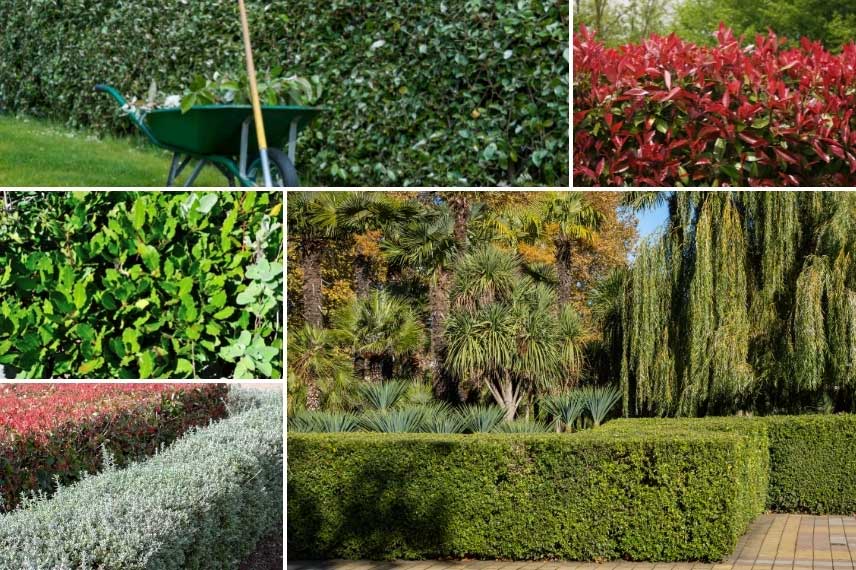
Elaeagnus ebbingei, Photinia fraseri, Laurus nobilis, Teucrium fruticans ‘Azureum’ and trimmed hedge of Pittosporum tobira
- Subscribe!
- Contents
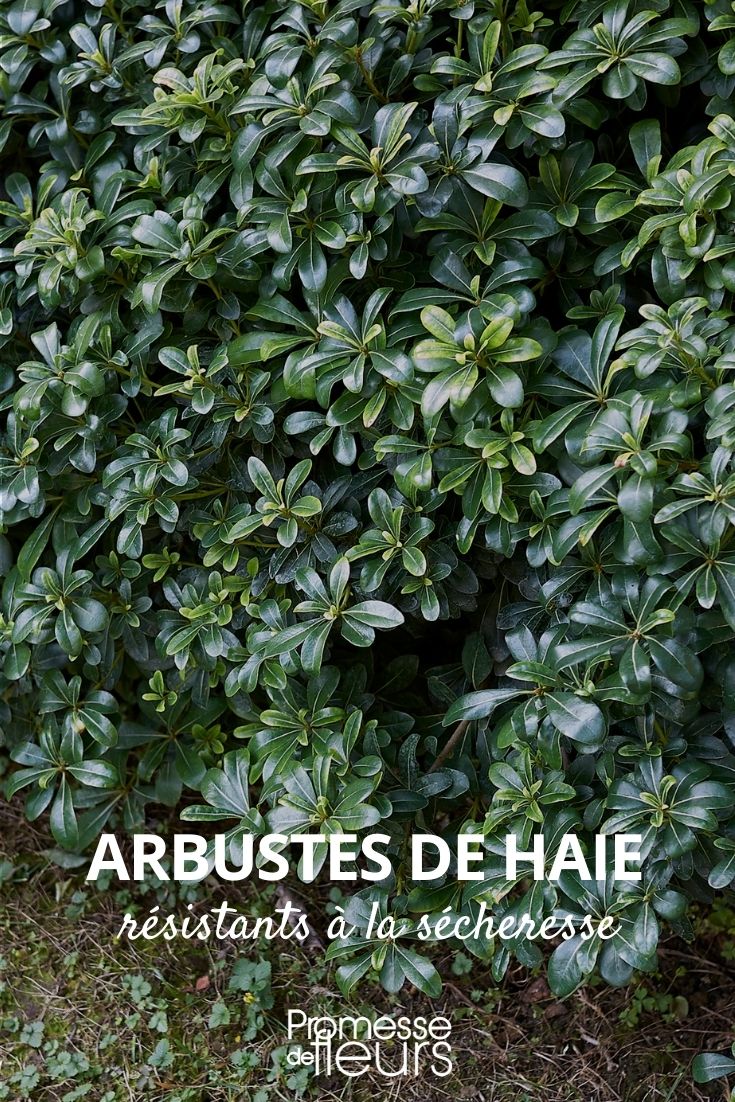
































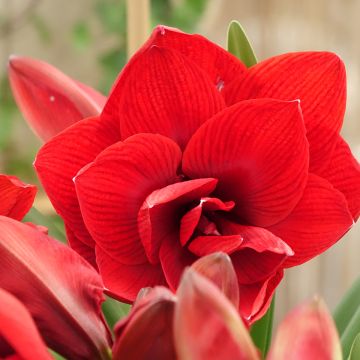

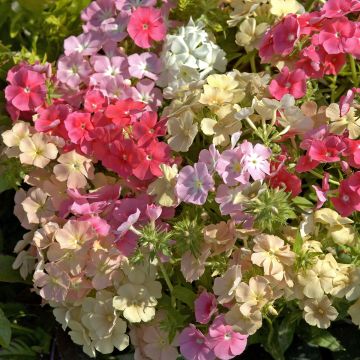
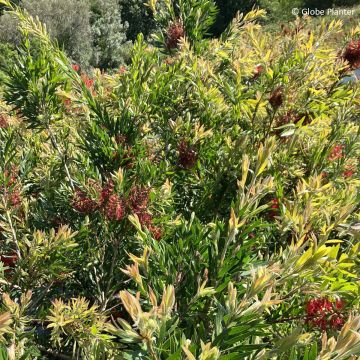
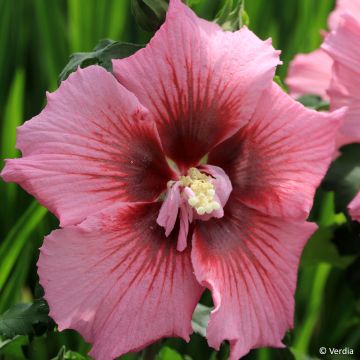

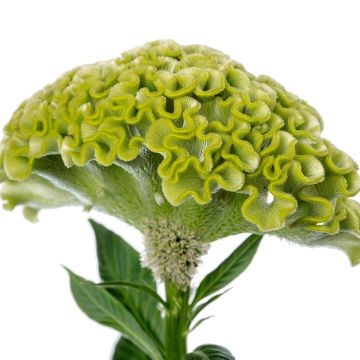
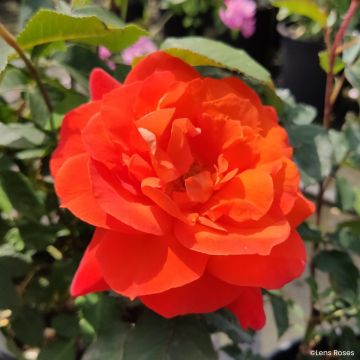
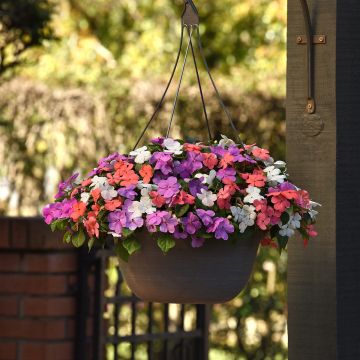
Comments